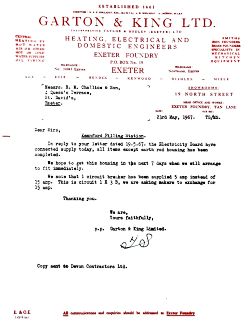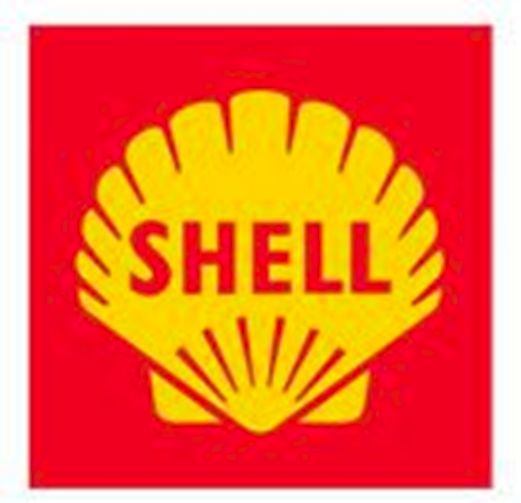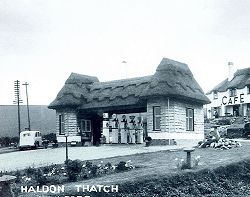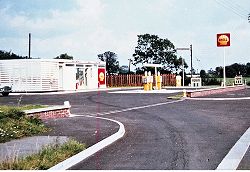

 I have recently been able to add another example of Headed Notepaper, this time from the 1960s, to the Stationery Cupboard page and there are now ten examples of variations of this Garton & King Ltd’s notepaper, statements, invoices and letter headings from the period of the 1930s through to the 1970s.
I have recently been able to add another example of Headed Notepaper, this time from the 1960s, to the Stationery Cupboard page and there are now ten examples of variations of this Garton & King Ltd’s notepaper, statements, invoices and letter headings from the period of the 1930s through to the 1970s.
This latest addition draws attention not only to the printed text with its description of trades and services offered by the Company but on this occasion a somewhat neglected area of expertise - commercial electric installations - as can be gleaned from the subject matter in the letter. It is fortunate that this has come to light as most observers of the activities of Garton & King Ltd associate the Company with manhole covers, gears, AGAs and heating installations and little more, the small print on the headed notepaper implies a far greater range of skills and services offered.

 Shell Mex & BP Ltd was formed in 1932 when the companies decided to merge their UK operations (details on Wikipedia) They ‘demerged’ their UK marketing operations in 1976. From 1966 onwards the BP & Shell Station networks became managed separate sales organisations.
Shell Mex & BP Ltd was formed in 1932 when the companies decided to merge their UK operations (details on Wikipedia) They ‘demerged’ their UK marketing operations in 1976. From 1966 onwards the BP & Shell Station networks became managed separate sales organisations.

 It was in 1966 that plans were drawn up for the proposed rebuilding of the Shell Filling Station at Kennford, Exeter. This particular location is familiar to local motorists and holidaymakers alike and is referred to locally as the ‘Splatford Split’ where the roads to Torbay (A380) and to Plymouth (A38) diverge but this name does not appear on any road signage. The petrol star rating system was introduced at this time (1967) and pumps and tanks installed to dispenses Shell Economy (2 star, 92 octane), Shell (3 star, 95 octane) and Super Shell (probably 4 or maybe 5 star, 98 – 101 octane.) A ‘Derv’ (which stands for Diesel Engined Road Vehicle) tank & pump was provided and Paraffin was available. 4 Star petrol was about 30p to 35p per gallon (6/- to 7/- shillings).
It was in 1966 that plans were drawn up for the proposed rebuilding of the Shell Filling Station at Kennford, Exeter. This particular location is familiar to local motorists and holidaymakers alike and is referred to locally as the ‘Splatford Split’ where the roads to Torbay (A380) and to Plymouth (A38) diverge but this name does not appear on any road signage. The petrol star rating system was introduced at this time (1967) and pumps and tanks installed to dispenses Shell Economy (2 star, 92 octane), Shell (3 star, 95 octane) and Super Shell (probably 4 or maybe 5 star, 98 – 101 octane.) A ‘Derv’ (which stands for Diesel Engined Road Vehicle) tank & pump was provided and Paraffin was available. 4 Star petrol was about 30p to 35p per gallon (6/- to 7/- shillings).
There is still a Shell Filling station on the site but it is vastly different from the ‘Modernisation’ Plans of January 1966 and the categories of fuel offered has changed completely. The 1966 plans were drawn up by Challice & Sons of St Davids, Exeter on behalf of Shell - Mex & BP Ltd, and the main Contractors were Devon Contractors Ltd. Garton & King Ltd submitted a tender for the Electrical Installation Works in December 1966 and their tender was accepted. Somewhat more involved than wiring a domestic property I would imagine, safety being a major concern bearing in mind that flammable fuel was being retailed.
The 9th May 1967 Letter (below left) refers to the delay caused by B.I.C.C. (British Insulated Callender's Cables) and the supply of the concrete casing for the Earth Rod. I have also shown here (below right) a copy invoice dated June 1967 describing the work and costs. A second page gave a typed record of G & K’s employees involved in the work, Dow, Bradbury, Lill and Foster (who is described as ‘boy’) no initials or first names are shown. It is possible the Company were involved as contractors for other Shell Station upgrades but this location is perhaps the best example I have come across with regards to documentation and of course it’s a well known location.
 Bearing in mind the need to meet strict standards with regards to Electrical Wiring and Safety at Petrol Stations it was remarkable that for many years the Haldon Thatch Filling Station, barely half a mile away at the junction (before the present layout was constructed) of the A380 and A38 at the bottom of Telegraph / Haldon Hill up until late 1930s had a thatched roof cladding as did the Haldon Café seen behind and to the right in the postcard image. No doubt standards were more lax in those times though a disaster waiting to happen one might think – strangely the café did experience a devastating fire! This filling station was a ‘Free House’ with regards to petrol brands retailed which included Cleveland, National Benzole, & Shell as well as others.
Bearing in mind the need to meet strict standards with regards to Electrical Wiring and Safety at Petrol Stations it was remarkable that for many years the Haldon Thatch Filling Station, barely half a mile away at the junction (before the present layout was constructed) of the A380 and A38 at the bottom of Telegraph / Haldon Hill up until late 1930s had a thatched roof cladding as did the Haldon Café seen behind and to the right in the postcard image. No doubt standards were more lax in those times though a disaster waiting to happen one might think – strangely the café did experience a devastating fire! This filling station was a ‘Free House’ with regards to petrol brands retailed which included Cleveland, National Benzole, & Shell as well as others.
 To date I have been unable to source an image of the Kennford Filling Station that came into service in 1967 but this image taken in 1964 of the Filling Station on Horncastle Rd (A158), Wragby, Lincolnshire shares a similar Shop Design and Pump Island (although only one) to the 1967 Kennford Shell site.
To date I have been unable to source an image of the Kennford Filling Station that came into service in 1967 but this image taken in 1964 of the Filling Station on Horncastle Rd (A158), Wragby, Lincolnshire shares a similar Shop Design and Pump Island (although only one) to the 1967 Kennford Shell site.
(Thanks to John Edwards, Wragby, Lincs, for use of the image)
Below is the current Kennford Shell Site with extensive canopy. Even with a slip road provided to enable re-joining the four lane carriageway, motorists wanting the A38 to Plymouth face a significant challenge as the ‘A38 / A380 Split is barely ½ a mile away and the traffic is always fast moving. Plymouth-bound motorists are faced with crossing two very active lanes to get onto the A38!
May 2023
Top of page
See also:
Services — Products — Heating
Exeter Cathedral — Saltram — Eggesford House
Devon & Exeter Hospital
Sitemap / Contents